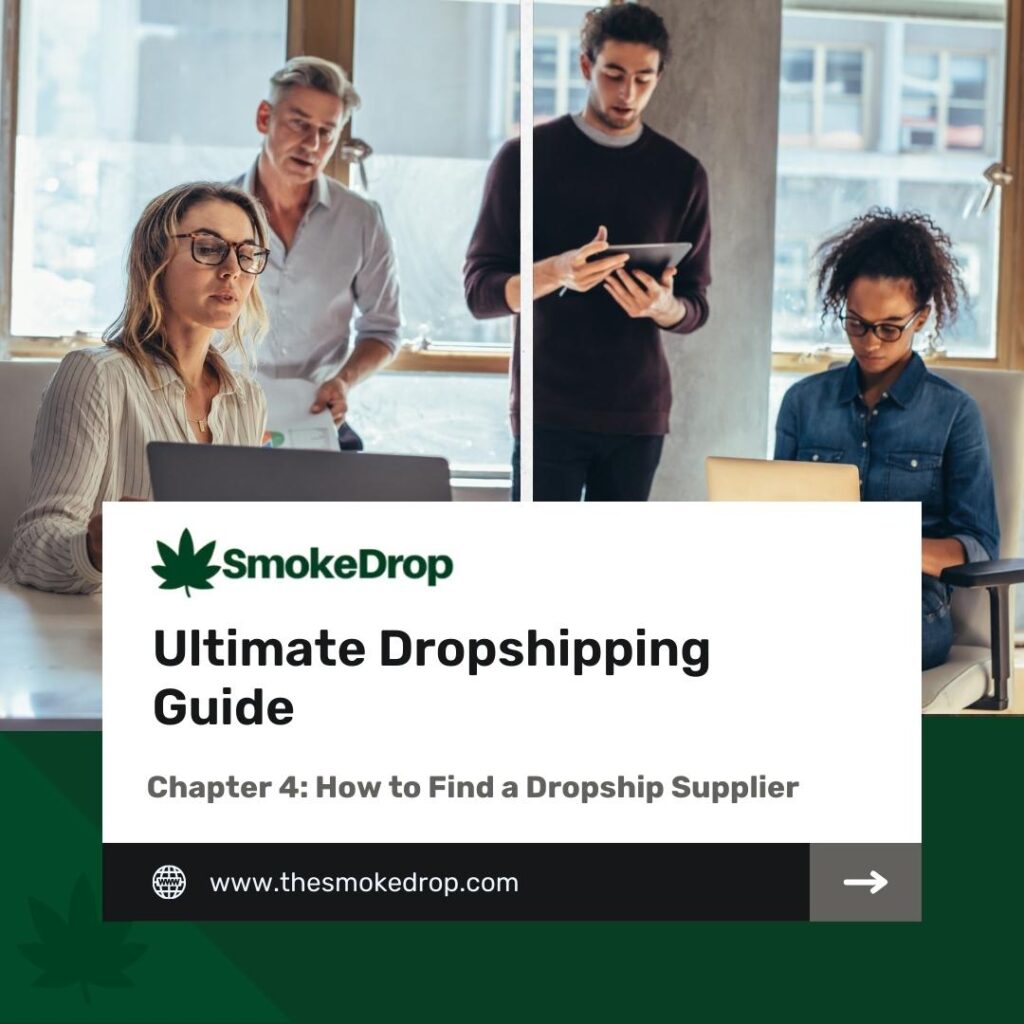
The quest for the perfect dropshipping supplier demands some effort, but the investment pays off in long-term savings, efficiency, and reduced headaches.
Establishing a strong relationship with your chosen supplier and implementing effective supplier enablement strategies are pivotal for ongoing success.
Understand the Supply Chain
Understanding the intricacies of the supply chain process is fundamental in pinpointing reliable dropshipping suppliers. Products typically originate from manufacturers, some of which also extend dropshipping services. Opting for manufacturers offering both wholesale and dropshipping can be advantageous, providing cost-effectiveness and maximizing profit margins. A crucial inquiry is whether the chosen dropshipper directly sells wholesale or collaborates with distinct dropship distributors.
In cases where manufacturers lack an in-house dropship process, they may engage with wholesale distributors who, in turn, make the products available to you at an increased price. It’s essential to delve into the supply chain and discern if there are any additional layers, such as secondary wholesalers. Unveiling the precise source helps minimize unnecessary intermediaries, ensuring optimal profit margins. While a dropship wholesaler may be of high quality, the goal is to identify the one offering the most value and cost benefits for your specific needs.
Assess Your Dropship Needs
To set the stage for a thriving dropshipping venture, start by determining your business needs and goals. This crucial step involves creating a list detailing the specific requirements for a dropship supplier that aligns seamlessly with your ecommerce strategy. Weed out options that demand volume commitments beyond your fulfillment capabilities. Evaluate profit margins based on your product costs and unique selling proposition, ensuring their pricing plans harmonize with your budget. Opt for dropship wholesalers interested in a mutually beneficial partnership, prioritizing long-term collaboration over one-sided terms.
Start Networking
Don’t hesitate to tap into your network for insights. Reach out to friends, family, and colleagues who have navigated the waters of dropshipping successfully. Explore online forums and social media hubs dedicated to dropshipping, such as Facebook’s dropshipping groups or Quora’s dropship threads. These communities readily share valuable experiences and offer advice, presenting opportunities for referrals to top-notch partners. Even if a potential dropshipper doesn’t align perfectly with your needs, inquire about referrals. Industry contacts often hold the key to discovering more tailored, smaller-scale operations that might better suit your requirements.
Dropship Supplier Directories & Apps
Looking for a reliable dropship supplier? Let’s explore two avenues: dropship supplier directories and apps. Directories, essentially curated lists on websites, present a comprehensive lineup of potential suppliers. However, the process doesn’t end there; contacting and gaining approval from suppliers is still on your to-do list. Moreover, managing product imports and updates for your store adds another layer of complexity, whether through manual efforts, developers, or dropship automation software, each consuming time or budget.
On the flip side, dropship apps streamline the process. They take the reins in sourcing products, eliminating the need for direct supplier communication. Integrating these apps into your ecommerce store, such as through platforms like Shopify, is a hassle-free experience. Select your desired products and effortlessly import them into your store. To kickstart your journey, we’ve compiled a list below featuring some of the top players in both dropship supplier directories and apps.
Dropship Supplier Directories
Searching for a dependable dropship supplier? Let’s begin by exploring some valuable resources in the world of supplier directories:
The Smoke Drop stands out as a dropship automation platform for Headshop products, seamlessly integrating your online store with a network of suppliers and retailers.
Unique to The Smoke Drop is its free directories, featuring actively monitored suppliers with a dropship product feed.
A speedy solution, Wholesale Central categorizes dropship suppliers by product type, simplifying your search for the right fit.
With a supplier directory encompassing over 8,000 companies across 75 product categories, Salehoo is a significant resource.
Access to this extensive list comes at a reasonable upfront fee of $67, backed by a 60-day money-back guarantee.
A stalwart in the industry, Worldwide Brands boasts an impressive directory of 8,000+ suppliers.
While a comprehensive view of the list requires an upfront $299 lifetime membership fee, the extensive network is geared toward long-term benefits.
These resources offer diverse entry points into the world of dropshipping, each with its unique features and offerings.
Dropship Supplier Apps
Exploring dropship supplier apps for your online store? Let’s check out a few noteworthy options, each offering unique features to streamline your dropshipping venture:
Renowned for leveraging AI to uncover winning products, Sell The Trend has evolved into an all-in-one dropshipping app.
Benefit from instant access to millions of dropshipping products and utilize the user-friendly “push-to-store” feature for quick product page creation. With its simple 1-click order fulfillment, it’s a service worth exploring.
A popular choice among Shopify users, Oberlo is a robust dropshipping app sourcing products from Chinese suppliers.
While the app facilitates a quick start, it’s essential to conduct extra research for product quality assurance. Note that shipping times might be extended due to products originating from China.
Offering versatility, Dropified allows you to source from various dropship suppliers, including US-based Aliexpress suppliers, ensuring faster product delivery.
Enjoy features like 1-click product importing, bulk customizations, automatic pricing rules, easy variant setup, and more. Plus, it integrates seamlessly with eBay for efficient automation.
With a notable 60% of suppliers based in the US or Europe, Spocket emphasizes quick product delivery.
Features like 1-click order processing, branded invoicing, and the option to order samples enhance your dropshipping experience.
Tailored for custom apparel and accessory online stores, Printful operates as a print-on-demand dropshipping app.
All products ship from the US, ensuring fast delivery. Keep in mind that print-on-demand products may have a longer turnaround time due to production processes.
These apps cater to various needs, making your dropshipping venture more accessible and efficient. Choose the one that aligns with your business goals for a seamless experience.

Evaluating Dropshipping Suppliers
When venturing into the world of dropshipping, not all suppliers are the same. Each supplier brings a unique set of offerings, from the depth of product data to their dropshipping policies. As you embark on evaluating potential dropshipping partners, pay attention to these key areas that can significantly impact your business:
Supplier Product Quality and Authenticity
In every industry, scrutinizing product quality and authenticity is paramount.
Thoroughly research and read reviews to ensure you build your retail business around trustworthy suppliers. Watch for consistent grammatical errors, as these can signal counterfeit products. If prices seem too good to be true, exercise caution, especially with electronics, and be wary of China dropshipping due to potential counterfeit concerns.
Supplier Customer Service
The responsiveness of a supplier’s customer service is a crucial factor. If you, as a potential reseller, face extended delays in receiving responses via email or phone, it might be a red flag.
Good customer service can compensate for inevitable hiccups in the partnership. The ability to address questions, handle returns, and manage delayed shipments efficiently is vital.
Supplier Warehousing and Shipping Options
Consider the geographical scope of your sales (U.S., Canada, International) when assessing suppliers.
Multiple warehouses, while adding complexity, can be advantageous. They offer cost savings on shipping and prove beneficial for those with warehouses in different countries. For instance, having warehouses in both Canada and the U.S. strategically addresses trade/tariff laws, facilitating smoother and more affordable cross-border shipping.
When it comes to dropshipping, the right partner can significantly contribute to your business’s success. Take the time to thoroughly evaluate these aspects to make an informed and strategic decision for a successful partnership.
Supplier Return Policy
As you stride toward becoming a flourishing retailer, embracing returns as a part of the business journey is inevitable. Understanding your supplier’s return policy is a pivotal aspect, ensuring it doesn’t leave you in a precarious situation. This scrutiny becomes even more critical when dealing with dropship suppliers.
Managing Inventory Feeds
In dropship retail, where high SKU volumes and narrow profit margins are the norm, the quality and accuracy of the inventory feed wield significant influence over your operations. If you find yourself dropshipping myriad products with thin margins from diverse suppliers, the supplier’s provision of essential details such as product images, titles, MSRP, descriptions, and, in certain cases, categories become almost indispensable. A seamless daily feed that accurately reflects inventory quantities and updates on new products is paramount for the smooth functioning of your business.
Building Good Supplier Relationships
Starting Out on the Right Foot
After diligently exploring various wholesale distributors and pinpointing the ideal supplier for your business, you’re poised and eager to kickstart your venture. The logical next step involves applying to your chosen dropship supplier, gaining approval as a reseller, and commencing the process of uploading their products to your sales channels. However, before diving headlong into the excitement, it’s crucial to ensure your initial communication with this prospective partner sets the right tone.
Making a Good First Impression
The wholesale application or initiation with a new supplier might seem straightforward, yet some resellers stumble at the outset, potentially hindering their approval. In the business world, as in personal relationships, the first impression carries substantial weight. Whether you’re embarking on a new personal relationship or initiating a business connection through your first email or application, the manner in which you present yourself in those initial moments can have a lasting impact on your relationship.
Crafting Polished Communications
Consider this hypothetical scenario: you submit an email to your chosen distributor with a tone similar to the following:
“I would like to sell your products. Send me catalogs and prices, especially on your bestsellers. I’ll be setting up an Amazon account and building a website soon. I don’t have any money, so I need to sell your products as fast as I can to pay my bills.”
While some suppliers might overlook a less-than-polished application, others could be more discerning, potentially deleting emails like this without responding to or approving the application. Although most people may not send emails as poor as this example, it’s essential to conscientiously gauge how your initial communications reflect on the potential longevity of your relationship with the supplier and the approval process for your application.
Establishing Professional Communication with Your Supplier
When opening communication with your wholesale supplier, consider these valuable tips to ensure a professional and business-savvy approach:
Project a Business Image: To be in business with partners, present yourself as a legitimate business entity. Invest in a domain name for your company, which can serve as both a blog and your ecommerce website. Whether you sell on eBay, Amazon, or through a dedicated platform like Shopify or WooCommerce, having a registered domain related to your business enhances brand control and ownership.
Domain Registration Matters: Registering a domain through services like GoDaddy or Web.com is a straightforward process, usually costing around $9/year. Owning the domain often comes with a free email service for your domain account. Instead of emailing suppliers from generic addresses at Hotmail. Yahoo, or Google, like johnsmith@hotmail.com, leverage the credibility of a domain-specific email like johnsmith@stashoutlet.com. It’s a simple yet effective way to be taken more seriously from the outset.
Polished Communications: Before hitting “send,” take a moment to review your email. Ensure it is free from spelling or grammar errors, adheres to correct capitalization and punctuation, and maintains a professional tone. Business writing differs from casual online communication, so avoid emojis or informal language.
Strategic Subject Lines: Craft a subject line that clearly indicates the nature of your email, such as “New Wholesale Account Question” or “Pre-Application Question for Wholesale Reseller Account.” This assists the recipient in directing your inquiry to the appropriate team, expediting the response process.
Research Before Asking: Check if your queries are addressed in the supplier’s FAQ or policy page. Demonstrating that you’ve taken the time to explore their website adds to your professional image. Instead of asking generic questions, delve into specifics, showing your commitment to understanding their business.
Clarity and Courtesy: If you still have questions, seek clarity by referencing your research. For instance, phrase your inquiries like, “I have reviewed your Shipping & Returns Policy at the link in your footer; however, I wanted to confirm XYZ detail.” This shows a thoughtful approach.
Comprehensive Signature: Conclude your emails with a professional touch by including your business name and basic contact details in your email signature. This provides a clear overview of your identity and facilitates smoother communication.
Initiating Contact for a Retail Account: A Simple Guide
By incorporating these practices, you lay the groundwork for a positive and professional relationship with your wholesale supplier from the outset.
When suppliers request you to initiate contact for an account application, crafting an effective email can set the stage for a successful relationship. Consider the following example:
Subject Line: New Retail Account Request
Hello,
My name is John Smith from Stash Outlet, Inc., located in Los Angeles, California. I discovered your company through The Smoke Drop Supplier Directory. After thoroughly reviewing your program details and product catalog, I am interested in establishing a retail account with you.
Please inform me of the required information and qualifications, and I’ll provide them promptly.
Thank you,
John Smith
Stash Outlet, Inc.
Email: John Smith@stashoutlet.com
Phone: 888-999-7777 ext 15
This straightforward email is sufficient to initiate the process. If the supplier’s application process is clear on their website and you have no initial questions, proceed to complete the application. However, if you need to seek additional details or confirm the application process, an approach similar to the one above will suffice.
Creating a positive first impression with a new wholesale supplier doesn’t demand much. A well-crafted email can expedite the approval process, ensuring a favorable beginning to your new business relationship.
The Supplier-Retailer Relationship
Maintaining positive relationships with your suppliers is a strategic move that can offer various advantages, including competitive pricing, favorable terms, and reliable product availability. These relationships form the backbone of successful online retail, resembling the model adopted by giants like Amazon or eBay.
In online retail, the common approach involves merchants procuring goods from wholesalers and then selling them at competitive prices. The key to thriving in this model lies in fostering strong ties with suppliers who wield control over crucial aspects such as prices, payment terms, shipment dates, and product availability.
For those steering an ecommerce business along these lines, the significance of a healthy rapport with wholesale distributors cannot be overstated. The question then becomes: How can you initiate and sustain these valuable relationships to ensure the smooth functioning of your online business?
Consider the following tips to build loyal and lasting supplier relationships that will lay the foundation for success:
Communication is Key: Maintain open lines of communication to discuss terms, expectations, and any potential challenges.
Reliability Matters: Demonstrate reliability in your orders, payments, and overall business conduct to foster trust with your suppliers.
Understand Their Perspective: Grasp your supplier’s challenges and objectives. Aligning your goals with theirs can create a mutually beneficial partnership.
Timely Payments: Ensure timely payments to reinforce trust and reliability, making you a preferred and valued partner.
Regular Check-Ins: Periodically check in with your suppliers to address concerns, discuss performance, and explore opportunities for collaboration.
By adhering to these principles, you can establish and maintain supplier relationships that contribute significantly to the success of your online business.
Building Strong Supplier Relationships
Creating enduring partnerships with your dropshipping suppliers is paramount for the success of your online business. Here are some practical tips to fortify these relationships and ensure your ecommerce venture thrives:
1. Pay on Time: Your suppliers are integral to your business, and timely payments build trust. Recognize that wholesale distributors often operate on thin margins, and consistent, on-time payments solidify your status as a valued customer.
2. Share Key Business Information: Foster open communication by keeping your suppliers informed about your business. Share updates on staff changes, promotions, and new product lines. This exchange of information can uncover additional services your supplier offers, enhancing collaboration.
3. Establish Clear Sales Expectations: Communicate your sales forecasts to help suppliers plan their inventory effectively. Avoid last-minute requests, as this can strain the relationship. Transparency in your sales expectations contributes to a smoother partnership.
4. Gather the Right Documents: Streamline the ordering process by understanding the documents your suppliers require. Whether it’s spreadsheets, faxes, or Electronic Data Interchange (EDI), being prepared minimizes errors and expedites order processing.
5. Strike Up Real Conversations: While emails are efficient, real conversations are invaluable. Schedule occasional phone calls, invite supply team members to company events, or meet for coffee. Face-to-face interaction fosters a deeper understanding and can turn suppliers into advocates for your brand.
6. Be Prepared for Uncertainties: Recognize that uncertainties in manufacturing, inventory, and shipments are inevitable. Patience during these challenges is crucial. Uphold positive supplier relationships even when faced with setbacks to ensure long-term success.
Conclusion
Cultivating strong supplier relationships goes beyond transactions; it’s an investment in the longevity and prosperity of your online business. With positive partnerships, you can unlock benefits such as better pricing, flexible terms, and enhanced product availability. Suppliers may even become advocates for your brand, contributing to your business’s growth and resilience in the competitive retail landscape.



